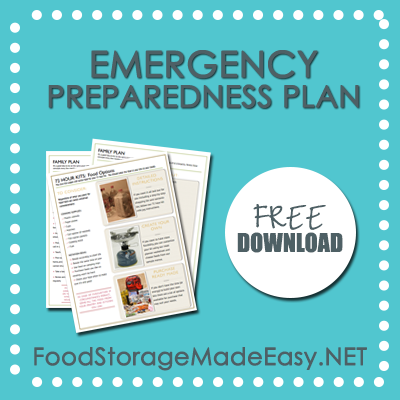
Last week for our 5th year Blogging Anniversary we introduced our brand new Emergency Preparedness Plan. Today we wanted to talk a little bit more in depth about the plan.
Here are some of the main differences and additions:
WHAT’S THE SAME:
- The three main sections are still the same: Family Plan, Disaster Kits, Evacuation Lists.
- There’s still room for you to fill in emergency contact info and other important components of your family plan.
- We still give a menu of food for you to put in your 72 hour kits (and other necessary items for cooking, etc.)
- We continue to talk about the necessities needed to keep your car stocked and having a game plan for things you would grab in case of an evacuation.
WHAT’S DIFFERENT:
- The file is a pdf file now. You can print it out easily even if you don’t know how to print from excel without all the extra spaces and lines.
- We changed the Disaster Kit titles to include the words “72 Hour Kit”, and “Emergency Binder”. The new titles are more descriptive of what is included in each section. We also added the word “Car Kit” to the Evacuation section
- We included tips and facts throughout the whole plan to help you in your planning and purchasing processes. These tips are things we have learned ourselves as well as reader suggestions that have helped us.
- Instead of giving you just the one menu plan for the food in your 72 hour kits, we included several lists of menus depending on varying diets. We also included meal planning worksheets for you to make your own custom menus.
TIPS FOR YOUR KITS
After finishing the new plan, we decided to give it a test and printed it out before going through our 72 hour kits that needed rotating. The plan flowed very well, and we’re confident it will help you rethink (or start) your plan. Here are some additional tips to think about when putting together your plan and kits. A lot of these are included in the plan, but we thought since we had your attention we would share them here too.
PURCHASING: After you’ve come up with everything you still need to buy for your kit, break it up into a purchasing schedule. Purchase just 1 or 2 things each week for however many weeks it takes you. The point is you’ll be making progress, even if you can’t buy it all at once.
GRAB LIST(S): Instead of having just one grab list (things you would grab if you have to evacuate) have multiple lists- one for each family member. Tape those lists up on the inside of your front closet door. When it comes time to evacuate, anyone who is old enough can get their list and hurry. This will save time deciding who is going to grab what.
INDIVIDUAL KITS: For anyone old enough, make them their own kit. Have food, water, and clothes in each kit so in case of separation everyone will have their own stuff. Divvy up the remaining supplies among all the kits. Put the heavier stuff in the stronger family members’ kits. Use backpacks or rolling bags that are easy to transport. Lugging around big rubbermaid bins is HARD.
TRIAL SIZE TOILETRIES: There are sample sizes of shampoos, toothpastes, deodorants etc. you can purchase for the kits. They are in the regular personal hygiene aisles at the store. No need to lug around big containers of those things. Another idea is to save the samples you get at hotels and put those in your kits. They always get thrown away anyways if you only use a small portion!
THRIFT STORE CLOTHING: It can be inconvenient and kind of wasteful to store regular usable clothes in your kits that stay stored in a closet while children outgrow them. Consider purchasing outfits at a thrift store for your kits. That way you wont have to feel bad about not using whole outfits while they still fit.
COLD WEATHER BAG: There are a lot of items you might want in your 72 hour kit if it were cold- but you wouldn’t want if it were warmer weather. Store all the stuff you would need in colder weather in a separate bag or container that you would grab and go in case of emergency during the winter. If it happened to be warmer, you could just leave it behind.
PUT FRESH FOOD ON GRAB LIST: If time, circumstance, and space allow – grab any fresh food you may have and throw it in a cooler on your way out (if you are leaving in a car). You may really appreciate fresh produce in the first 24-72 hours of a crisis.
DIAPER BAGS PACKED: This goes for evacuations OR everyday emergencies. Do your best to ALWAYS have your diaper bags packed with extra food, clothes, and diapers. If you’re in the habit of doing this all the time it could really save you in a REAL emergency (like those don’t happen daily with babies on the go).
IDEAS FOR ROTATION: Depending on how often your kit needs rotating (the foods you chose will dictate this), make it a habit to change them out at the same time each year. Whether it be Halloween (where you use some of the extra candy as comfort food), Spring cleaning week, April Fools Day (we did that last year so we wouldn’t be fools- we know it was corny) or any other time of year, get in the habit of rotating and re-evaluating them.
COMMUNICATION: If in case you are evacuating and you expect your house to be in tact when you return, it’s wise to maybe leave a note about your where-abouts on a door. That way when people come looking to see if you are safe – they will know you are elsewhere.
And now, I’ll leave you with a picture of part of my kits sprawled out all over my family room floor. Dumping and pouring your kits out is a sure way to MAKE YOURSELF rotate the food and clothes in there. The food got older, and my kids got bigger since I did this last. Oh and yes, that’s our NEW PLAN printed out on the floor in front of everything. I used it to guide myself through the task 🙂


-Jodi Weiss Schroeder
http://foodstoragemadeeasy.net

